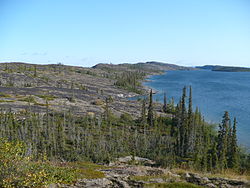Thaidene Nene National Park Reserve is a national park reserve in the Northwest Territories of Canada. At the eastern end of Great Slave Lake in the Northwest Territories, the proposed Thaidene Nëné national park reserve is part of a larger group of proposed protected areas around the East Arm and Artillery Lake regions. Thaidene Nëné is a culturally rich area, including the traditional and present-day hunting, fishing, gathering and spiritual areas used by various Aboriginal peoples.
Understand
[edit]It covers an area of approximately 33,000 km² (12,741 sq mi), which is larger than Belgium.
Łutselk'e, a community of 300 people (formerly called Snowdrift), is the access point to the park reserve. It is the epicentre of Northern Dënesųłiné culture and the headquarters-in-waiting of Thaidene Nëné National Park Reserve. The town is proudly traditional, with the Chipewyan language widely spoken and traditional hunting, trapping and fishing serving as the economic mainstay.
History
[edit]Thaidene Nëné means ‘Land of the Ancestors’ in the Dënesųłiné—or Chipewyan—language. The Łutsël K'e Dene First Nation consider Thaidene Nëné to be the ‘heart of the homeland’ and a sacred place. Thaidene Nëné has long been an important cultural area for the people of Łutsël K’e Dene First Nation and their ancestors as described in their vision. The Northwest Territory Métis Nation also has long standing ties to the Thaidene Nëné area as do other Aboriginal groups.
The Thaidene Nëné area was first visited by Europeans in the early 1800s, explored for northern travel and trade corridors including the route used to access the tundra from Great Slave Lake, now known as Pike’s Portage. The remains of Fort Reliance, which served as a base in searches for the missing John Ross expedition and later the missing Sir John Franklin expedition, is also in the proposed national park reserve. Fort Reliance is designated as a national historic site and a territorial historic site.
In February 2019, the Lutsel K'e Dene First Nation voted in favour of the proposed reserve and approved agreements between the community, the government of Canada and the government of the Northwest Territories to create the park. They hope to develop tourism resources for the benefit of the community. The Yellowknives Dene First Nation, however, oppose the agreements because they are concerned that the park might impact their treaty rights to hunt, trap and fish.
Landscape
[edit]
The proposed Thaidene Nëné national park reserve has a dramatic transition from the boreal forest of the Taiga Shield to above tree-line in the southern Arctic tundra. It is an outstanding example of the Northwestern Boreal Uplands Natural Region.
The Thaidene Nëné area is characterized by lakes, rivers and waterfalls, a striking archipelago of islands, peninsulas, landscape formations shaped by ancient ice sheets, dramatic red granite cliffs, a variety of climates, soils and ecosystem processes.
Flora and fauna
[edit]The vegetation varies from open woodlands and forests carpeted with mosses and shrubs, to lichen-covered tundra with occasional clumps of low-growing plants.
This diverse ecological region is also home to many boreal and tundra mammals such as barren-ground caribou, moose, muskox, grey wolf, black and grizzly bear, red and Arctic fox, lynx, wolverine, otter, beaver, muskrat, and many species of birds and fish.
Climate
[edit]Visitor information
[edit]Contact the Protected Areas Establishment Branch, Parks Canada, +1 867-766-8460 or email [email protected]
Get in
[edit]To get there, you can hop on a scheduled or charter flight to Łutselk'e from Yellowknife.
- Air Tindi. At least one flight a day from Yellowknife, 45 min, $275 one-way $225 for senior or child), taxes included.
Fees and permits
[edit]As of 2024, there are no fees or permits required.
Get around
[edit]Hike, canoe, kayak.
See
[edit]- Explore Fort Reliance National Historic Site/Old Fort Reliance Territorial Historic Site at the mouth of the Lockhart River. Built as a winter camp by George Back during his 1833 overland expedition down the river that now bears his name, Fort Reliance lies at the eastern extremity of Great Slave Lake, on the brink of the Barrenlands. The Hudson’s Bay Company rebuilt the fort in 1855. Visitors can explore the old stone chimneys and ruins of the log structures.
Do
[edit]Visitors and local residents use the area for boating, camping, fishing, berry picking and hiking.
- Hike up to Tyrrell Falls and learn about the traditional village site known as Kaché with Łutsël K’e Dene First Nation’s Ni hat’ni Dene Watchers of the Land Program;
- Boat through The Gap into Wildbread Bay; and
- Christie Bay: the deepest fresh water body in North America, home of huge lake trout. Catch Whitefish, Lake Trout, Inconnu and more.
- McLeod Bay shelters Lake Trout a century old.
- The East Arm is home to Arctic Grayling at the base of inflowing waterfalls and Northern Pike in shallow bays and channels.
- Hike Pike’s Portage from Fort Reliance to Artillery Lake through the Barrens – a region of glacial eskers, rock-ribbed hills, and artifacts from the Chipewyan and Caribou Inuit cultures.
Buy, eat, and drink
[edit]There is a single grocery store, the Lutselk'e Co-op, in Lutselk'e.
Sleep
[edit]- Plummer’s Lodge (at Taltheilei (“open water”) Narrows, the gateway to McLeod Bay), toll-free: +1-800-665-0240. 3-day trips for US$2,500/person, 4-day trips for US$3,000/person, or 7-day trips for US$4,300/person..
- Trophy Lodge (near Reliance), ☏ +1 867 873-5420. Weekly $3,100 per person plus 5% tax. Nightly rate is $450 plus 5% tax without air transport. Meals and food are not provided.
- Indian Mountain Lodge near Utsingi Point
- Frontier Fishing Lodge (just outside of Lutselk’e), toll-free: +1-877-465-6843. Includes flight from Yellowknife, guide, boat, fuel, and all meals. 7 days $4200 + 5% tax, 4 days $2500 + 5% tax, days $2900 + 5% tax.
If you go backcountry camping, be sure to practice "no-trace" camping.
Stay safe
[edit]There is a two-person Royal Canadian Mounted Police detachment and health centre with two nurses in Lutselk'e.
